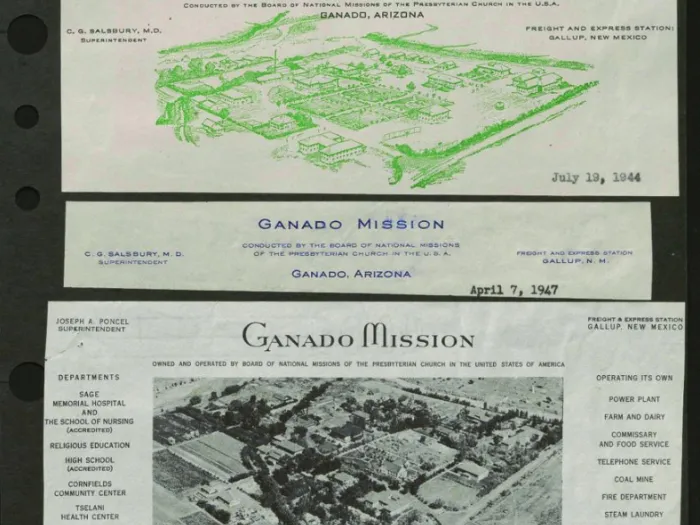Scattered throughout the PHS building on 425 Lombard Street are several museum items on display. If you've visited us, perhaps you've seen a few of them—like Cornelia, our small reed pump organ that sits on the first floor, welcoming researchers into our Reading Room.
But for those of you who are scattered across the country—across the globe, even—there may not be a chance to wander our halls or our Philadelphia city block. And so, we present: The Curio Cabinet. Here, you’ll find images and descriptions of some of the objects preserved and presented throughout our building.
ITEM ONE—Model Ship—BEULAH
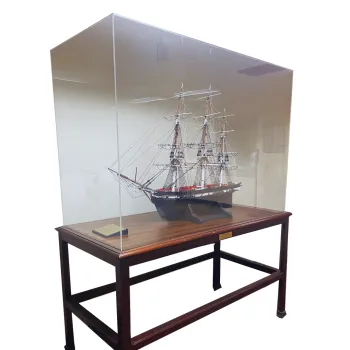
Venture down the stairs, onto the lower floor, and you'll come across Beulah, a model ship first created in 1826. The plaque tells us its scale—every 3/8 inch equals 1 foot—as well as its makers.
MODEL BUILT BY THE SAILORS OF THE BARQUE “BENJAMIN RUSH” RETURNING FROM CANTON, CHINA AND PRESENTED TO JOSEPH EASTBURN, MARINER’S CHURCH, PHILADELPHIA, PA
Our Beulah is a “sailors’ votive model of full-rigged ship,” and was restored in 1984 by one William C. Wester. She now lives on the bottom floor of our building, where staff members pass it on their way to the break room, and visitors may glimpse it as they head to the restroom or meeting room.
A Place for Sailors to Pray
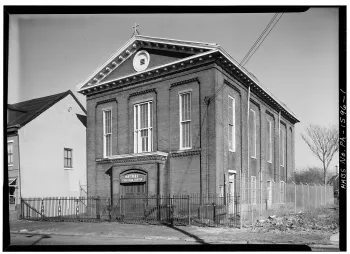
Mariners' Bethel Church, 923 South Front Street, Philadelphia, Philadelphia County, PA Photos from Survey HABS PA-1596. Photo courtesy of the Library of Congress.
The Mariners' Presbyterian Church mentioned above was established in 1819 by Joseph Eastburn, the man to whom Beulah was presented in 1826, four years before the church was formally organized by the Presbytery of Philadelphia. Until it was destroyed by a fire in 1963, the church ministered to sailors as well as to the city's poor and indigent in conjunction with the Seamen's and Landsmen's Aid Society. In 1965, Mariners' merged with the Third and Scots Presbyterian Church; the resulting Third, Scots and Mariners' Presbyterian Church, better known as Old Pine Street Church, still stands at 412 Pine Street (our neighbors!).
See RG29: Guide to the Mariners’ Church (Philadelphia, Pa.) Records
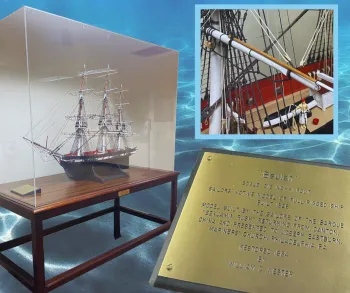
***
ITEM TWO—Typewriter—THE TENNEYS
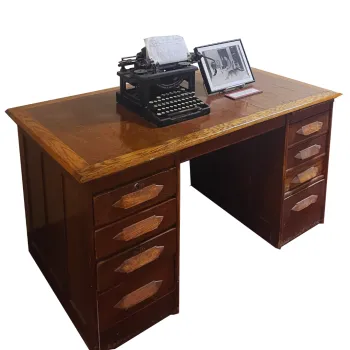
The piece of paper locked and loaded into the typewriter that lives on our bottom floor isn’t just for show. Visitors will discover, if they lean over the desk and train their eyes to the letterhead, that the words typed there provide a bit of context. It reads:
HISTORICAL FOUNDATION OF THE PRESBYTERIAN AND REFORMED CHURCHES
FEB.27th.,1933
This typewriter was first used by Mrs. S. M. Tenney during the time she maintained a small shop in Texarkana. The typewriter was kept in the back of the shop and at odd moments Mrs. Tenney did copy work, typing for the public, and transcribing pencil notes taken from the old church session records by the Rev. S. M. Tenney and his son, Robert. Upon this typewriter much of the ground work for the development of the Historical Foundation was done. The Tenney’s continued to use this machine during the Foundation’s early years in Montreat.
The typewriter isn’t the only museum item in this image, however. The desk itself is, too—it was used by the Reverend Samuel Mills Tenney, who is mentioned above. Rev. Tenney was the first curator of the Historical Foundation of the Presbyterian and Reformed Churches.

A Homegrown Preservationist
The Rev. Samuel Tenney, a traveling Presbyterian minister from Texas, was ordained in 1893. For the thirty years that followed, Tenney was the pastor for ten different congregations, while also serving as chaplain for the state prison and a mental institution in the city of Rusk, Texas.
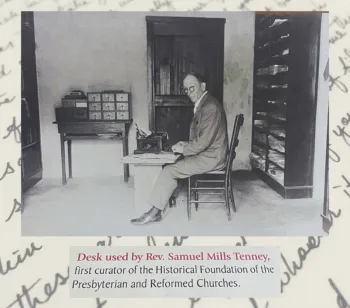
While rummaging through second-hand shops in his state, the Rev. Tenney stumbled upon a variety of historic paper ephemera, including manuscripts by Rev. Robert Lewis Dabney—chief of staff to Stonewall Jackson during the Civil War, founder of Austin Theological Seminary, and a Presbyterian minister himself—and began collecting them. (The Dabney manuscripts now live in the archives of the seminary he founded.)
His interest in collecting these items he found grew at a fast pace, until, in 1903, he created the Presbyterian Historical Society of the Synod of Texas and became a member of the Presbyterian Historical Society in Philadelphia (that’s us!). Tenney began reaching out to synods and congregations to deposit their records with him and his new organization, for safekeeping. At this point in time, however, many church records were held by private individuals, who had no interest in parting with them.
During World War I, Tenney served with the Red Cross. Unfortunately, during this time, he came down with influenza which accelerated hearing loss he suffered since he was young.
Tenney’s loss-of-hearing became so acute that he was unable to continue serving as a traveling minister. With high hopes for a boost in his spirit, Tenney headed to Princeton Theological Seminary in 1924 for his class reunion. Stopping in Philadelphia along the way, he found the boost he was searching for at PHS—not only in meeting Dr. Louis Benson, the then-librarian of the society, who was also deaf, but also in the realization that perhaps his hobby could be turned into a career.
On his return to Texas, Tenney found a home for his Historical Society at the old Texarkana National Bank building (where Mrs. Tenney first used this typewriter). He and his son returned to the Texas preaching circuit, making a little coin and copying down church records by hand.
.
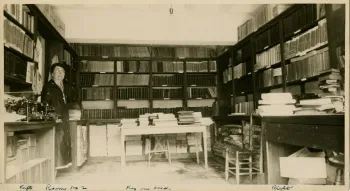
Mrs. Tenney in the Reading Room at Montreat, 1928. [Pearl ID: islandora:86222].
From Texarkana to Montreat
In 1925, two things happened: PHS was designated by the Presbyterian Church in the U.S.A. (the Northern denomination)s the official Department of History, and the Rev. Tenney offered the Presbyterian Church in the United States (PCUS)his collection of historical items and records. The following year, the PCUS accepted the offer, hiring the Tenney’s to oversee the collection, renaming Tenney’s historical society the Historical Foundation of the Presbyterian and Reformed Churches, and moving the collection from Texas to North Carolina.
See The Two Samuels: February 2018 blog post about Samuel Agnew and Samuel Tenney
You may freely reuse and distribute this article in its entirety for non-commercial purposes in any medium. Please include author attribution, photography credits, and a link to the original article. This work is licensed under a Creative Commons Attribution-NonCommercial-NoDeratives 4.0 International License.




